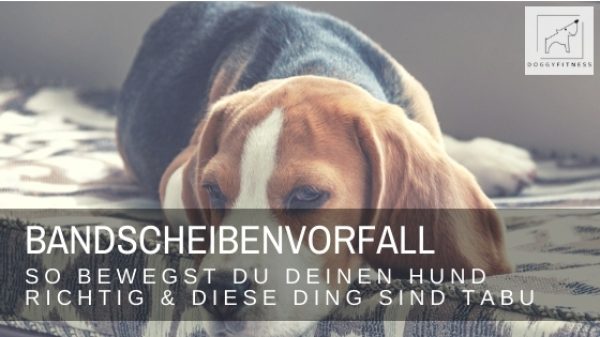When a dog has suffered a herniated disc, the first thing you think is that he needs everything at that moment, but no movement. But this is only true to a limited extent. After a herniated disc, the dog may be paralyzed on the hind legs, or even all four legs, depending on the severity and location of the herniation. At the very least, however, neurological problems and gait disturbances are very likely. Herniated disc dog movement
No wonder, because the prolapsed disc material caused pressure on the spinal cord and nerves and this subsequently causes impaired nerve transmission.
Paralysis and disturbed movements unsettle dog owners herniated disc dog movement
As a dog owner, you want to do everything right then, especially since the disturbed movements, balance disorders or even paralysis understandably frighten us and we are in great concern for our dog. In addition, a herniated disc is painful, just like for us humans, very painful. So we are very helpless at first.
That is why box rest is very important in many cases
Correct in terms of exercise after a herniated disc is in any case that your dog was prescribed rest. In many cases, even box rest is prescribed. This serves to prevent the affected dog from making uncontrolled movements and to allow the trauma to recede. You should definitely make sure that your dog is well bedded and that his joints and spine are supported in a way that is easy on the joints. On the other hand, it is also very important, even indispensable, to work immediately after a herniated disc to improve nerve conduction and get the patient “back on track”. herniated disc dog movement
How can this be achieved and isn’t it contradictory?
It is recommended to start physiotherapy in the first 24-48 hours. This applies regardless of whether the herniated disc has been operated on or is being treated conservatively. The goal is to relieve pain and relax overworked areas. Musculature and mobility should be maintained and trained. Nerve conduction is trained. This counteracts neurological disorders. It is important to train your dog’s coordination and body awareness. Likewise, a healthy exercise routine is important.
Involving the dog owner in exercise training is important for the dog’s recovery! herniated disc dog exercise
The treating therapist should then give the dog owner the first movement exercises with which to train movement sequences. Of course, these are always individually adapted to the state of health of the dog. The first step is usually to start with assisted standing and getting up. The dog’s joints are also passively moved, simulating normal movement and encouraging movement initiation.
According to the development of the dog, the movement exercises are then successively expanded. This is how supported walking is then practiced. Isometric exercises can also be used a lot after a herniated disc. It is important that this is always done in consultation with the treating therapist.
What about walks when the dog begins to walk independently again?
In the first 4-6 weeks strict leash restriction is announced. The movement and load should be adapted to the state of the disease. Very short exercise sessions throughout the day are very important. Here you should really start with a few minutes. Long walks, jerky movements and tight turns are taboo. You should also avoid jumping, climbing stairs and short stops. Riding other dogs should be avoided at all costs. The same applies to patting and patting on the back by humans. If the dog has suffered a herniated disc in the cervical spine, your dog should definitely wear a harness. herniated disc dog movement
Extra tip: In wet and cold weather, I recommend that you put a dog coat on your dog. This protects his back.
What about dog sports after a herniated disc?
Competitive sports are absolutely taboo after a herniated disc. The risk of another herniated disc is great and your dog’s back is his weak point. Therefore, after the recovery of your dog, I recommend you at most sports activities that are easy on the joints, such as Degility or Mobility.
Can the dog dig, play and run after a herniated disc?
As a dog owner, you want to give your beloved four-legged friend as normal a life as possible. However, there is often a lot of uncertainty about what the dog is actually still allowed to do. Of course, you have to weigh what will harm the dog, but on the other hand, keep in mind his fun and quality of life. Often the affected dogs are difficult to keep calm after weeks of rest and leash restriction. However, I recommend avoiding your dog playing wildly and moving uncontrollably. Wild tugging should also be avoided, as well as jumps and turns that put a lot of stress on the spine. herniated disc dog movement
These are suitable alternatives for your dog
A controlled and well-dosed contact with other dogs I think is good and important, but the owner should pay attention here accordingly and let reason prevail. So that your dog is not frustrated, you can additionally keep him busy with e.g. search games (hiding treats, hiding food dummy), playing with a sniffing carpet etc. Regular exercise training, which should accompany your dog during recovery but also afterwards, can also become an exciting activity for your dog.
Do you have any questions about how to properly exercise your dog after a herniated disc? Then feel free to share them with me in the comments or email me at: tina@doggy-fitness.de.
herniated disc dog movement
Dieser Beitrag ist auch verfügbar auf:
Français (French)
Deutsch (German)
Español (Spanish)
















